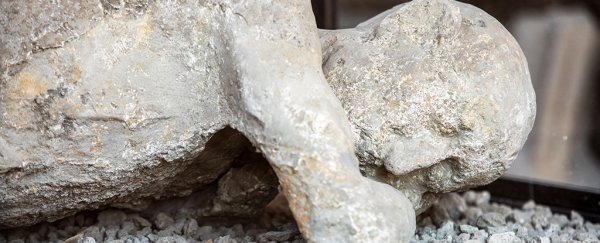Send those history books for a reprint, sharpen your Wikipedia editing skills, and adjust your answer for the next pub trivia night. It turns out that the destruction of Pompeii probably happened sometime after 17 October 79 CE and not, as has been previously thought, on August 24.
That's based on a newly discovered message written on one of the ancient city's buildings, referring to "the 16th day before the calends of November" – or, as it's more commonly known, the 17th day of October.
Considering it's tricky to scrawl on a wall when smothered with suffocating ash from Mount Vesuvius, that has to cast doubt on the accuracy of August 24, the date most historians have been going with until now.
That date had been based on the best archaeological findings and contemporary writings of the time, including a well-known letter by Roman lawyer and author Pliny the Younger, who wrote about witnessing the event from the other side of the Bay of Naples.
"Today, with much humility, perhaps we will rewrite the history books because we date the eruption to the second half of October," said Italy's culture minister Alberto Bonisoli, The Guardian reports.
In fact, despite Pliny the Younger mentioning August 24 as the date of the main Vesuvius eruption in his letter, historians have never been able to precisely date the resulting disaster of Pompeii.
There's always been some doubt about it – not least because Pliny the Younger's letters were written decades after the event.
Calcified fruits on tree branches that would have grown later in the year were uncovered back in the 19th century, for example, which caused some experts to have second thoughts. Braziers have also been found in the ruins, suggesting a date closer to winter.
The new message helps to narrow down the actual date, if indeed the writer and their timekeeping can be trusted.
Thanks to the latest large-scale excavations in southern Italy, the text was discovered on a plain white wall, in a house that was apparently being renovated when Vesuvius exploded.
"Being charcoal, fragile and evanescent, which could not last a long time, it is more than likely that it was written in October 79 CE," the head of the Pompeii site, Massimo Osanna, told the press.
Osanna says the correct date may in fact be the 24th of October – but it's difficult to narrow it down to a particular day.
Archaeologists continue to uncover fascinating artefacts from Pompeii, even nearly 2,000 years after the city was buried in several metres of ash and pumice from Vesuvius. Earlier this year, the remains of a horse were found buried in the dirt.
And if you want to see what was lost in the disaster, check out the 3D virtual tour of Pompeii put together by researchers a couple of years ago.
It's because of the preserving properties of the volcanic ash that we know so much about Pompeii and the events that unfolded there. Archaeologists think the entire city was consumed in a period of just 25 hours from the first blast, claiming the lives of more than 1,000 residents.
Excavation work on the site of Pompeii and its surrounding areas continues, so archaeologists are still discovering new facts about the tragic events of 79 CE - including the date of when they actually took place.
